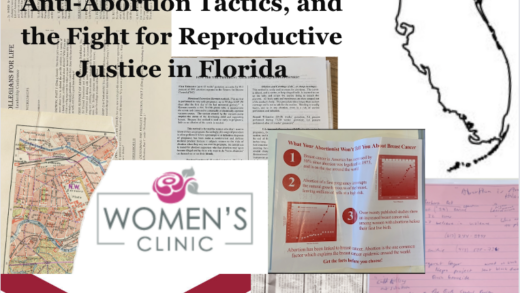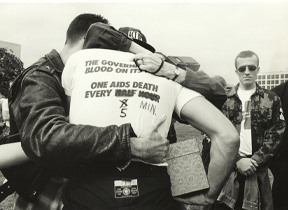by Vivian Weissman

This podcast is about one of the pillars of reproductive justice, the right to have children, and how that pillar is directly at stake when we think about health care access to family-making options for queer people. This podcast talks about the struggles of queer family making, influenced by heteronormative society, how and why options like IVF were in question during the 2024 election, and how the right to have children is in danger for queer people with the Trump administration taking over. Through archival papers, as well as other sources, this podcast explores the attempted societal erasure of queer families through lack of access to options for family-making, and the ways in which people are working to combat these heteronormative stereotypes about what a family should look like.
Transcript
We’re living in a unique moment of heightened political and social turmoil. On November 5th, we were at a time when so many people’s rights were on the ballot. As we work our way towards the next four years, the Trump administration’s policies stand out as a promise to work hard to gain control of people’s reproductive rights. Today, we’ll be talking about queer reproductive rights in healthcare, specifically reproductive technologies such as in vitro fertilization in relation to queer family making, and the current threats posed against them. Let’s get into it.
*Musical interlude*
One of the pillars of reproductive justice is the right to have children, and that pillar is directly at stake when we think about health care access to family-making options for queer people. While the results of this recent election are a direct threat to that pillar, queer family making has been an expensive, hard endeavor for a long time – a result of systemic homophobia and long-standing repression of queer love.
This deeply ingrained erasure is having a resurgence, especially when looking at the Trump administration, Project 2025, and the rhetoric surrounding the ideal “American Family” that was heavily pushed in the Trump Vance campaign. A large part of Vice President elect JD Vance’s campaign promise was to make America more pro-family. But what does that mean? To Vance, it means a patriarchal family in which there is a mother and a father, and the mother stays home with the children while the father works and financially supports the family. Vance believes that the left has built quote “an entire political movement that is explicitly anti-child and anti-family,” saying that America is run by “a bunch of childless cat ladies who are miserable at their own lives and the choices that they’ve made.” But where does all of this pro-family, anti-single women discourse leave queer families who don’t fit into the binary, yet want to have children and create families?
*Musical interlude*
While there may be options for queer families, they are often hard to access as a result of oppression that is trying to control the population and who can and cannot have children. Things like adoption, insemination, and IVF cost more than most can afford, with barriers like court, custody battles, and a lack of medical insurance and healthcare to help pay for family-making options. All of this shows a lack of regard for and belief in non-hetreosexual and non-normative families and relationships. IVF was a big talking point on both the Democratic and Republican campaign trails, and Republican lawmakers intend to make IVF even more inaccessible than it already is.
Here is an excerpt from the 900 page Project 2025 document, it is their recommendation that the United States Department of Health and Human Services should quote “aggressively implement a plan to pursue and fund ethical alternative methods of research in order to ensure that abortion and embryo destructive related research, cell lines, and other testing methods become both fully obsolete and ethically unthinkable” (Project 2025, page 461). According to the policy-makers behind Project 2025, IVF, means for making children, should be banned on the premise that unused fertilized embryos may be discarded, equating that with abortion.
In June of 2024, Senate Republicans blocked a bill that would have made access to IVF and other fertility treatments a national right, showing just how opposed the right is to alternative families. In February of 2024, the Alabama Supreme court ruled that frozen embryos are “unborn children,” so that they may be viewed as such under Alabama’s Wrongful Death of a Minor Act. In this ruling, the Alabama Court made it possible for plaintiffs to sue IVF providers for discarding unused embryos in fertility clinics.
To understand why these actions are so targeted, and why the right is focused on population control through reproductive control, we must think about the types of people looking for alternative family making solutions. On that list? Queer people.
*Musical interlude*
To fully understand this current moment of political tension surrounding alternative family making, we must look at the history between queer people and the healthcare system, and how fertility treatments have always been hard to access due to homophobia. This current moment is a setback in a widespread fight for queer reproductive rights spanning decades. Queer people have always had a complicated relationship with the healthcare system, thinking about the AIDS epidemic and how it was furthered by the healthcare system ignoring it because the victims were majority gay people. The ways in which the healthcare system ignores and erases queer existence is still there when looking at reproductive technologies and queer couples trying to access them.
IVF is a process in which the egg is received through ovarian stimulation, then fertilized outside of the body before being transferred back into the womb. The first child was born out of IVF treatment in 1978, and the use of reproductive technologies for family-making has grown enormously since then. But still, queer couples looking for these kinds of fertility options face many of the same barriers they once did.
When looking through a collection in the Smith College archives, the Gena Corea papers, I stumbled across some of the research that she did for her book, The Mother Machine. While her book focused on a very different angle of IVF, her research included many newspaper clippings and letters from the time period. One “OB GYN News” newspaper clipping from 1981 entitled “Lesbians Fear Gynecologist’s Biases May Affect Care” speaks about the effects of homophobia on healthcare, showing that queer discomfort in the healthcare industry has been a prevalent issue for decades. It quotes “many lesbian women are concerned about the effect of physicians’ negative attitudes towards homosexuals on their healthcare,” showing that not much has changed since 1981. Another article from Corea’s research is a newspaper clipping from 1984, entitled “The Fetus and the Law: Whose Life is it Anyway?” This article looks at cases wherein pregnant women had their rights violated on behalf of the rights of the fetuses they were carrying, which relates to the ways in which the rights to reproductive healthcare is being taken away on behalf of fertilized embryos as opposed to women’s rights and wants.
It was only in 2015 that the Obergefell v. Hodges court case legalized gay marriage in the US, and even then, both same-sex parents having legal parental rights was not guaranteed. Couples were put in a situation where the parent who didn’t give birth had to adopt their child in order to legally be their parent, a very expensive, drawn-out, and emotionally invasive practice that still exists today.
During the early days of IVF, ideal candidates were married, straight couples. It wasn’t safe for queer couples to be out at that point, let alone create families. Randall Odem, a reproductive endocrinologist at Washington University says “in the early days, a lot of programs would only treat couples that literally had to prove they were legally married.” Considering that IVF became popular in the 1980s, long before gay marriage was legalized, we can see how same sex couples were historically kept from gaining access to reproductive technologies. These obstacles are still faced today, whether or not they are as obvious as they once were.
One cycle of IVF treatment can range in cost from 14,000 dollars to upwards of 20,000 dollars, not taking into account medication, storage fees, and if multiple cycles are needed. Health insurance rarely covers treatment for same sex couples, as infertility has not been historically defined with homosexual couples in mind.
And now, queer couples looking to expand their families face an even bigger threat – the threat of these treatments not being available at all. Instead of moving towards easier access to care and more options for queer families, we are moving back in time, a common theme we are seeing with the new legislation surrounding reproductive freedoms.
*Musical interlude*
To end on a happier note, let’s look at The Family Diversity Projects – a non-profit organization that tries to eliminate stigma and prejudice against different types of families through photographs that provide representation for different community groups. Smith College houses their archives, and when looking through them, I found one of their exhibits called “Love Makes a Family.” It’s a collection of portraits of queer people and their families, providing non-normative representation of what families can look like. By depicting different types of families through visual means, The Family Diversity Projects shows that families look different for everyone, and to be socially acceptable should mean to be a loving family, not necessarily a heterosexual or patriarchal one. The pictures are shown below, and invite us to question: What does a family look like? How do things like popular media and societal standards shape the ways we think families should look? And how are the ways in which queer people create families at risk because of the societal stigma around and attempted erasure of queer relationships? Take a look at The Family Diversity Projects, linked below, to challenge your ideas of what a family should look like and remember that it’s love that makes a family.






References
ObGYN newspaper clipping, 07-25-2019, SSC-MS-00242, Gena Corea Papers, Sophia Smith Archives, Smith College. https://findingaids.smith.edu/repositories/2/resources/1062
American Way of Birth newspaper clipping, 07-25-2019, SSC-MS-00242, Gena Corea Papers, Sophia Smith Archives, Smith College. https://findingaids.smith.edu/repositories/2/resources/1062
“Alabama Supreme Court Rules Frozen Embryos Are ‘Unborn Children’ and Admonishes IVF’s ‘Wild West’ Treatment.” American Society for Reproductive Medicine. https://www.asrm.org/news-and-events/asrm-news/legally-speaking/frozen-embryo-destruction-and–potential-travel-restrictions-for-surrogacy-arrangements2/.
Amelie24. “LGBTQ Family Building on the Rise.” Fertility Answers, June 16, 2024. https://www.fertilityanswers.com/lgbtq-family-building-on-the-rise/.
Bjcdnn. “Past, Present and Future of Fertility Care.” Barnes, March 3, 2021. https://www.barnesjewish.org/Newsroom/News-Releases/ArtMID/2560/ArticleID/1153/PAST-PRESENT-AND-FUTURE-OF-FERTILITY-CARE.
Choe, Jennifer. “In Vitro Fertilization.” StatPearls [Internet]., September 4, 2023. https://www.ncbi.nlm.nih.gov/books/NBK562266/.
“Exhibits.” FAMILY DIVERSITY PROJECTS. https://www.familydiversityprojects.org/exhibits.
Ferber, Sarah, Nicola Marks, and Vera C. Mackie. IVF and Assisted Reproduction: A global history. Basingstoke: Palgrave Macmillan, 2022.
“For Same-Sex Couples, a New Path to Legal Parenthood.” NBCNews.com, November 26, 2018. https://www.nbcnews.com/feature/nbc-out/same-sex-couples-new-path-legal-parenthood-n940081.
Groves, Stephen. “Senate Republicans Block Bill on Women’s Right to IVF as Democrats Make Push on Reproductive Care.” AP News, June 13, 2024. https://apnews.com/article/senate-ivf-alabama-reproductive-care-460d099153d3faf548e9326ff17dbae6.
Hassanein, Nada. “Few States Cover Fertility Treatment for Same-Sex Couples, but That Could Be Changing • Stateline.” Stateline, March 26, 2024. https://stateline.org/2024/03/26/few-states-cover-fertility-treatment-for-same-sex-couples-but-that-could-be-changing/.
“JD Vance: The US Is Being Run by ‘childless Cat Ladies’ | Fox News Video.” Fox News. https://www.foxnews.com/video/6265796735001.
Marley, Patrick. “Vance Once Advocated That Children Get Votes That Parents Could Cast.” The Washington Post, July 2024. https://www.washingtonpost.com/politics/2024/07/24/jd-vance-parents-kids-voting/.
“Obergefell v. Hodges.” oyez.org. https://www.oyez.org/cases/2014/14-556.
“Project 2025.” Reproductive Freedom for All, July 31, 2024. https://reproductivefreedomforall.org/resources/project-2025/.
Sutton, Erin, Lynn Shapiro Snyder, Amy K. Dow, and Susan Gross Sholinsky. “In Alabama, Pre-Embryos Are ‘Extrauterine Children’ under the State’s Wrongful Death Statute.” RSS, 2024. https://www.healthlawadvisor.com/in-alabama-pre-embryos-are-extrauterine-children-under-the-states-wrongful-death-statute.
Sutton, Erin, Lynn Shapiro Snyder, Amy K. Dow, and Susan Gross Sholinsky. “In Alabama, Pre-Embryos Are ‘Extrauterine Children’ under the State’s Wrongful Death Statute.” RSS, 2024. https://www.healthlawadvisor.com/in-alabama-pre-embryos-are-extrauterine-children-under-the-states-wrongful-death-statute.
Understanding the cost of IVF in 2024 | arc fertility. https://www.arcfertility.com/patient-resources/understanding-the-cost-of-ivf/. Winter, Jessica. “J. D. Vance’s Sad, Strange Politics of Family.” The New Yorker, July 25, 2024. https://www.newyorker.com/news/daily-comment/j-d-vances-sad-strange-politics-of-family.
The Family Diversity Projects: Further Reading
Click this link to learn more through The Family Diversity Projects: https://www.familydiversityprojects.org/exhibits/love-makes-a-family


